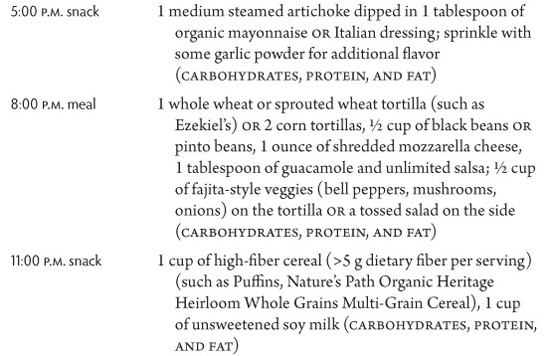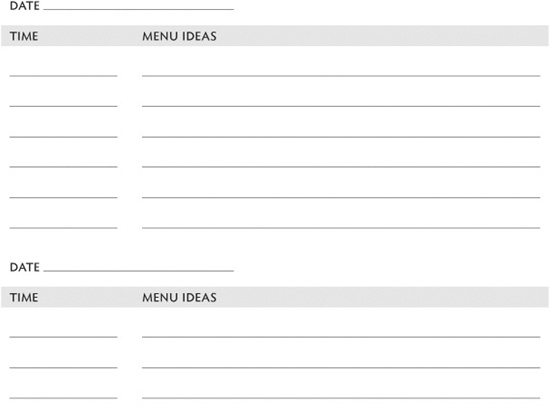The 200 SuperFoods That Will Save Your Life (59 page)
Read The 200 SuperFoods That Will Save Your Life Online
Authors: Deborah Klein


Sample 2000 Calorie Livit #5


And to help you plan your own meals, make copies of the
My Livit!
chart on the opposite page and keep track of your progress.
My Livit!


From Deborah A. Klein,
The 200 SuperFoods That Will Save Your Life
. New York: McGraw-Hill, 2010.
Grocery Shopping
DECIPHER DIETARY DECEPTION
Before you go grocery shopping, be aware of the dietary deception on food labels. There are specific ingredients to look for and specific foods that cause concern. The key words to watch out for are
lite, free, diet,
and
sugar-free.
These words often translate into a packaged food that may contain carcinogenic chemicals, that is low in fiber and therefore has little satiety value, and that can actually increase your appetite.
If you see the words
diet
or
sugar-free
on a food product, leave it on the store shelf. Such foods often contain artificial colors or flavorings that may have links to attention deficit and hyperactivity disorder (ADHD) or cancer. Sugar-free foods get their sweetness from artificial sweeteners, at least one of whichâaspartameâhas been shown to make people even hungrier, due to its high level of sweetness.
The most predominant packaging deceptions are with frozen foods, breads, crackers, cereals, and yogurts. For packaged foods in general, look at the ingredients list and then check the amounts of fat, sodium, and fiber. Pay special attention to the amount of dietary fiber in all starchy foods (for example, bread, crackers, cereal, rice, and pasta).
Look for foods with three or more grams of dietary fiber per slice of bread or per snackâfor example, crackers and sports barsâand five or more grams per serving of cereal or per frozen meal.
High-fiber starches or starchy vegetables are whole wheat couscous, sprouted grain bread, oatmeal, quinoa, amaranth, barley, bulgur, brown or wild rice, lima beans, peas, sweet potatoes, yams, and winter squash.
High-fiber fruits include “S or S” fruitsâthose fruits with either edible skin or edible seedsâfor example, apples, peaches, pears, apricots, plums, strawberries, blackberries, cherries, blueberries, kiwi, and oranges.
High-fiber vegetables include the cruciferous vegetablesâbroccoli, Brussels sprouts, cabbage, cauliflower, chard, kale, mustard greens, rutabagas, and turnips. These have been shown to offer protection against certain cancers, and they are rich in fiber, vitamins, and minerals. Often a darker and richer color means that the vegetable is higher in fiber (for example, romaine lettuce and spinach have more fiber than iceberg lettuce). Focus on eating veggies twice a day, for example, with lunch and dinner, and aim for one cruciferous vegetable daily.
When choosing fruits and vegetables, getting variety in their color will help ensure that they provide a variety of vitamins and minerals (for example, broccoli, spinach, tomatoes, chard, kale, collard greens, zucchini, red bell peppers, yellow bell peppers, apples, berries, pears, oranges, and limes).
Aim for five servings of fruits and vegetables every day: two fruits and three vegetables. You can get one serving of fruit in any of these ways: one small fresh fruit (two inches in diameter), one-quarter cup of dried fruit (try to buy it naturally dried and unsulfured), one-half cup of fruit canned in its own juice, one-half cup of fresh fruit, or one-half cup of unsweetened fruit juice (100% juice). Drink a maximum of one-half cup of juice a day mixed with water to keep the calories from adding up so quickly. It's better to eat your fruit rather than drink it, so that you get the fiber and the increased feeling of satisfaction that comes with it.
One serving of non-starchy vegetables is one-half cup of cooked vegetables, one-half cup of vegetable juice, or one cup of raw vegetables.
Follow the Livitician's “3 Rule” to choose a low-fat food, defined as a food that provides less than 30 percent of its calories from fat. Look on a food label for the total grams of fat; multiply that number by 3, then add a 0 at the end or move the decimal one place to the right. Compare that number with the total calories. If the number is lower than the number of total calories, it provides less than 30 percent of its calories from fat and is therefore a
low-fat food.
As an example, consider a food that has 5 grams of fat and provides 180 calories: 5 Ã 3 = 15, add a 0 = 150, 150 < 180 =
low-fat food.
Eating low-sodium foods more often will help lower blood pressure and improve the health of blood vessels. Aim for less than 140 mg of sodium per serving for most products and less than 400 mg of sodium per serving for frozen foods. When eating a food that is high in sodium, drink a lot of water to flush the sodium from your system, and balance the high-sodium food with a lot of vegetables to provide more hydration and fiber.
If you have hypertension, aim for less than 1,500 mg (1.5 grams) of sodium per day. This is about the amount of sodium that is found in two-thirds of a teaspoon of salt. The American Heart Association and the federal Dietary Guidelines for Americans both recommend that healthy adults without any special risk factors have no more than 2,300 mg of sodium per day. For people who have already been diagnosed with heart disease, the American Heart Association suggests a maximum of 2,000 mg of sodium daily.
Bringing healthy food home is an obvious key to living a healthy lifestyle, but shopping trips are often not well planned. Schedule grocery shopping in your calendar once a week. Choose the store that is most convenient for you to get to, and when you are there, shop the perimeter of the store first for fresh foods.
Broaden your palate rather than your waist with a banquet of foods. Eat a varietyâthe world is full of delicious foods, so partake of them. The Talmud says that one of the first questions that will be asked when one gets to heaven is “Did you taste all the different fruits?” Instead of buying the same fruits, vegetables, and grains week after week, try a food that you have never tried before or that you rarely have, for example, bok choy, chard, kale, pluots, cherimoya, or quinoa.
When selecting foods to purchase, check the labels for low-fat (<30 percent of calories from fat), high-fiber (â¥3 grams of fiber per serving for snacks and >5 grams of fiber per meal) foods that are free of hydrogenated oils, artificial sweeteners, and artificial colors. Eat foods that are low in sodium (<140 mg of sodium per serving).
Always have staple Livit foods available in your house to help prevent noshing on “empty” caloriesâthose that do not provide many nutrients with the caloriesâand to prevent overextending the time between meals.
Here's a staple inventory list to start with. Please modify it based on your dietary preferences, and add other food items from the grocery lists provided by the Livitician. Both the list of staple foods and the grocery shopping list that follows are alphabetized within food group sections.
Staple Livit Foods
Carbohydrate Foods
Bottled organic low-sodium pasta sauce
Brown rice
Corn tortillas
Fresh or frozen organic fruit
Fresh or frozen organic starchy vegetables (for example, yams, sweet potatoes,
baked potato with skin, winter squash [butternut, spaghetti, acorn], green
peas, corn, edamame, lima beans)
Fresh or frozen organic vegetables
High-fiber cereals (such as oatmeal, Puffins, Shredded Wheat)
Organic low-fat milk
Organic low-fat yogurt
Organic vegetable-based soups in shelf-stable boxes (such as Imagine Butternut
Squash Soup, Pacific Natural Foods Cashew Carrot Ginger Soup)
Quinoa
Sprouted grain bread
Tomato paste
Whole wheat bread
Whole wheat couscous
Whole wheat crackers (such as ak-mak, Triscuit Reduced Fat)
Whole wheat pasta
Whole wheat tortillas
Protein Foods
Bean-based soups (for example, black bean, pinto bean, kidney bean, lentil,
vegetarian chili)
Canned beans
Canned tuna packed in water
Cottage cheese
Edamame
Fresh or frozen lean beef
Fresh or frozen organic chicken
Fresh or frozen organic turkey
Fresh or frozen wild fish
Low-fat cheese
Low-fat kefir drink
Nuts and seeds (almonds, peanuts, walnuts, soy nuts, pistachios, sunflower seeds, pumpkin seeds), raw or roasted
Organic all-natural peanut butter
Organic eggs fortified with omega-3 fatty acids
Ricotta cheese
Fat Foods
Extra-virgin olive oil, expeller-pressed
Flaxseeds, ground or milled
Guacamole
Non-hydrogenated organic buttery spreads (such as Earth Balance)